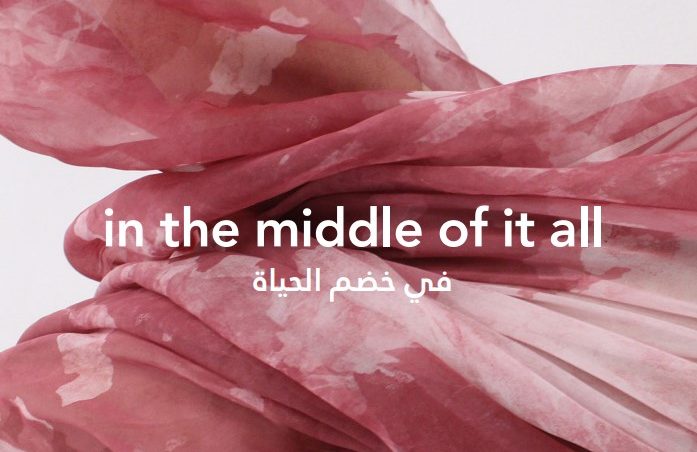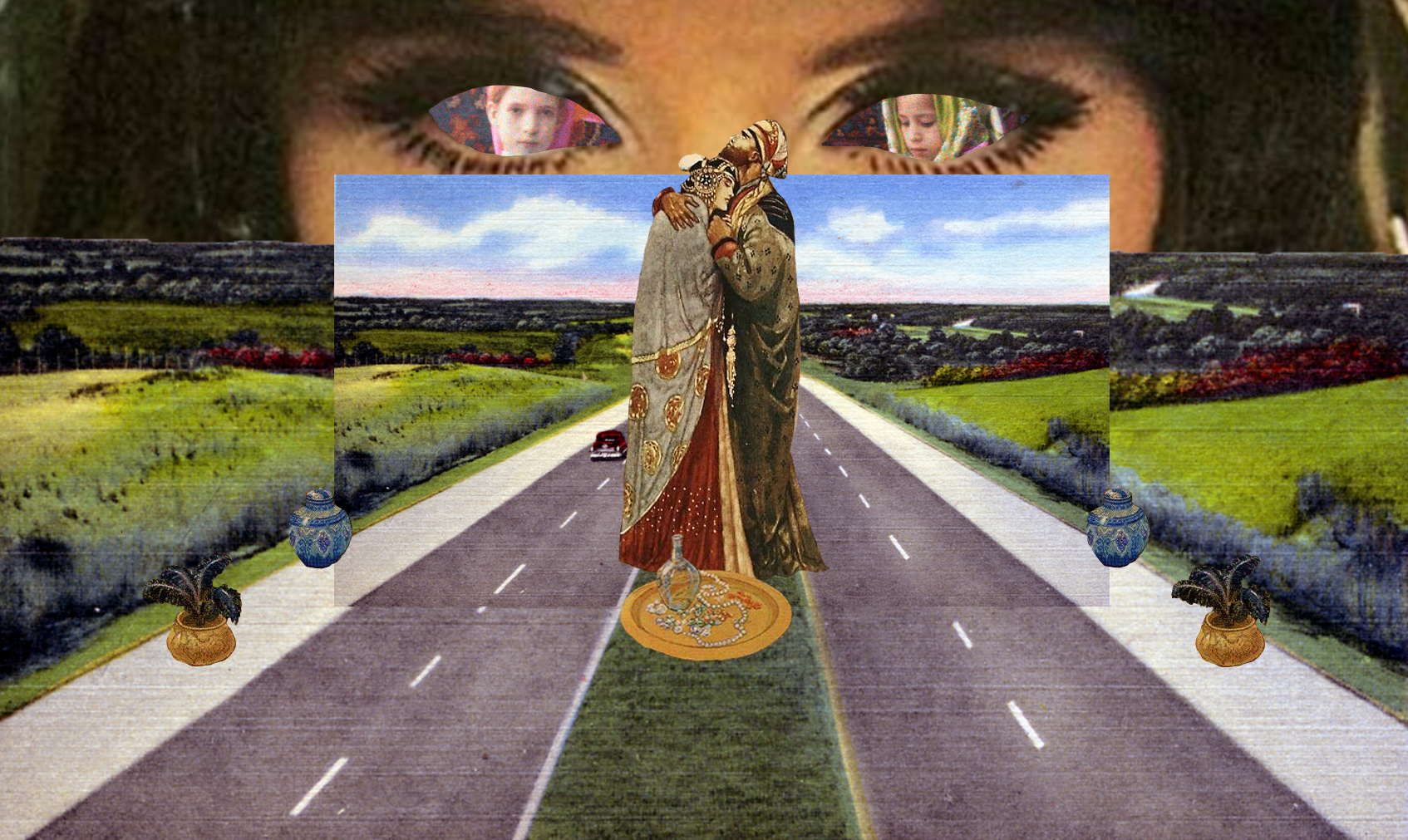
Cover page of ‘In The Middle of It All’ by Jana Ghalayini (courtesy: Banat Collective)
We are dedicating two weeks to storytelling in the United Arab Emirates, with featured interviews with writers and storytellers/sharers and an overview of interesting events and people telling stories about Dubai, Abu Dhabi, the region and the world. The second part of our series is a conversation with Sara bin Safwan, founder and curator of Banat Collective, a space encouraging conversation and collaboration between women artists in the region.
An independent platform for showcasing and discussing intersectionality and womanhood in Middle East and North Africa, the Banat Collective collects, curates, and shares a diversity of distinctive women’s art and creative voices. Abu-Dhabi based, Emirati founder and curator, Sara bin Safwan established the collective to form a space encouraging artists and creatives to create, connect, and collaborate, as well as participate, in dialogue about gender, identity, and experiences of womanhood in the region. Banat Collective recently produced their first book, ‘In The Middle of It All’ in which they collaborated with 31 artists to produce visual narratives of coming of age. Using multiple storytelling modes of photography, prose, collage, poetry, drawing, painting and mixed media, the book reflects experiences shared by women across the world, albeit set in the specific societal and cultural context of this region.
Mashallah News spoke to Sara bin Safwan over email to learn more about the story behind the collective and its journey so far.
Could you tell us a bit about yourself and your background?
I’m Sara Bin Safwan, founder and curator of Banat Collective, half-Honduran and half-Emirati. I have a bachelor’s degree in Culture, Criticism and Curation from Central Saint Martins College of Art and Design in London, and currently work as an Assistant Curator for Guggenheim Abu Dhabi.
What are your thoughts in general about women and art in this region?
I believe it’s a wonderful time to be a woman in the arts here. We are starting to see more and more women become artists and curators, most of whom are looking critically at the world that they live in. I’m surrounded by inspiring women in the arts who do not let their gender dictate the way they work. And I’m seeing many different projects and initiatives all over the world taking place that are promoting the strength and creativity of women in the Middle East and South Asia. It’s been inspiring to see so many women take action to say what they want to say, greatly contributing to multiple conversations about and between women of color.
Feminism for Banat means working towards authentic representations of a diverse group of women of this region. We think that this is an effective means of accomplishing the broader goals of any feminist project: equality. Banat hopes to be a platform for women to lend their voice to what must be a global conversation and not just a Western-centric one. We also didn’t want to do something too forceful and direct when it came to feminism and Arab identity; we wanted to take an approach that would ease the audience into these ideas by relating them to universal emotions such as changes in the body, position in the world, and nostalgia. Rather than potentially polarising the debate and provoking strong reactions, we have opted for a subtler and gentler way of acquainting our audience with ideas and themes which can often be rejected due to their provocative or unpopular connotations in popular culture. Like any region in the world, we have our long entrenched social norms which that we are trying to change and improve all the time.

Eman Bahraini (courtesy: Banat Collective)
“We hope to eliminate a stereotypical view of Arab women, replacing it with stories of smart and creative artists who have important world views to share,” says bin Safwan, encapsulating the spirit of the collective.
When and how did you come up with the idea of Banat Collective? ‘Banat’ means girls, but what does it stand for? And why a collective?
The idea to create Banat Collective came from an urge to do something new with my life after having moved back to Abu Dhabi once I had completed my studies. I was inspired and wanted to connect with artists from the region, continuing the conversations I’d been having during my time in London. I realised there was something missing: a space to create, connect and collaborate in the UAE. The desire for such a space, combined with my constant thinking about identity, gender and politics, subsequently led to the creation of Banat Collective. It became a way for me to both reaching out to artists and providing a platform for them to connect with others and begin new conversations about Arab women artists.
For me, the name banat, girls, suggests strength in collectivity. I believe a collective can harness the idea of togetherness and collectivity, which is an important value for Banat Collective. We hope to see more critical discussions about contemporary art and writing in the region through the work that we showcase and share. We also hope to eliminate a regressive, stereotypical perception of Arab women, replacing it with stories of smart and creative artists who have important world views to share.
What has been the response of artists in the region to the collective? What drew them towards it?
The responses have been enormously supportive. It really shows the need for creative spaces in this region, and that there is a lot of demand from the creatives for them. There is a constant need to showcase and discuss what is going on in the region as well as produce art which is meaningful and challenges current ideas.
Are you open to all kinds of subjects and issues? How do you wrestle with censorship, taboo topics, and art which subverts or challenges?
We engage in a diversity of conversations but do not limit ourselves to only hard hitting topics. People often think that Banat Collective is trying to start a social revolution. We are however rather trying to showcase the complexity and diversity of life in the Arab world.
It’s a common misconception that Arab art is inherently political – it is not. The topics and works we showcase are part of human nature, and just happen to be set within our specific cultural and societal contexts.
In the Arab world, art that may be seen as highly critical of something can sometimes translate into being threatening. Our focus is to try to represent an authentic perspective of topics that dominate and shape our everyday lives.

Moshtari Hilal (courtesy: Banat Collective)
Could you tell us more about the publication of your first book, ‘In The Middle of It All,’ which examines the subject of coming of age? Why did you feel it was important to create and curate art around this topic?
We are proud to introduce this publication as our first project, which let us focus our ability on collectively collaborating with artists and writers, and discussing meaningful topics that are not only universal and relatable but also sources of much stigma, both within the region and internationally. Through showcasing artworks that uncover personal histories and cultural intricacies, ‘In The Middle of It All‘ reveals diverse and authentic experiences of growing up, and hopefully demystify some stereotypical notions of the Arab woman.
The book contains work from 31 artists who all explore various moments of their lives through five chapters. One example is the work of artist Moshtari Hilal, which shows the tumultuous journey of how to love yourself and your body while constantly battling with white-washed beauty standards. It truly captures the confusion that a young woman goes through while growing up, fighting against conformity while finding one’s own individuality. Puberty is an overarching theme in the book, and takes on a dominant presence in many of the works. We hope that the book can serve as a true representation of women from the region, and that it will humanise Arab women by providing their narratives of experiences shared by women all over the world.

Nasreen Shaikh Jamal Al-Lail (courtesy: Banat Collective)
What made you choose this particular structure of the book, and how was the journey of working with so many collaborators?
The book takes on a visual narrative and consolidates artworks within different themed chapters, which constitute a non-linear structure and reflect the way that different moments and ideas can be both set apart and tied together. Artists either had to be invited to contribute or submit to us directly; we had to sift through over 70 submissions and collectively decide which artists to include in the book. It was thrilling to see so many submissions roll in, and the passion and commitment that the artists displayed towards the project.
What do you see for the future? Could you share any of Banat Collective’s upcoming projects or plans?
We hope to continue connecting creatives, either online or in real life, and we are working with a few collaborators who will write more for the Banat Collective website. I feel that the arts in region is headed in a positive direction; the online community at Banat is really strong in sharing ideas and I hope that this can translate into sharing more offline as well.


